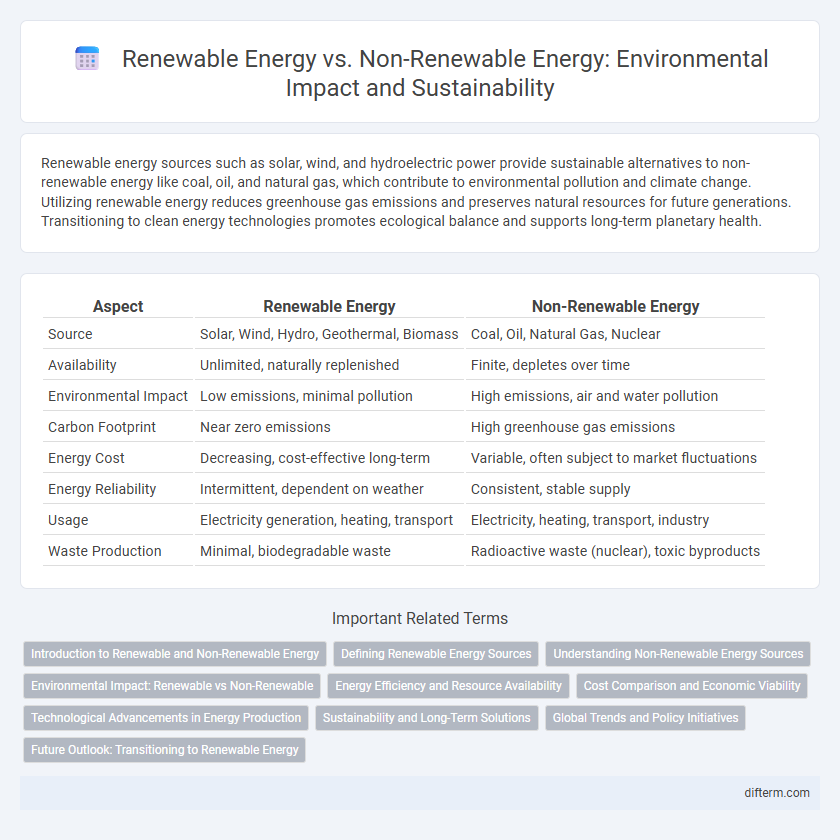Renewable energy sources such as solar, wind, and hydroelectric power provide sustainable alternatives to non-renewable energy like coal, oil, and natural gas, which contribute to environmental pollution and climate change. Utilizing renewable energy reduces greenhouse gas emissions and preserves natural resources for future generations. Transitioning to clean energy technologies promotes ecological balance and supports long-term planetary health.
Table of Comparison
| Aspect | Renewable Energy | Non-Renewable Energy |
|---|---|---|
| Source | Solar, Wind, Hydro, Geothermal, Biomass | Coal, Oil, Natural Gas, Nuclear |
| Availability | Unlimited, naturally replenished | Finite, depletes over time |
| Environmental Impact | Low emissions, minimal pollution | High emissions, air and water pollution |
| Carbon Footprint | Near zero emissions | High greenhouse gas emissions |
| Energy Cost | Decreasing, cost-effective long-term | Variable, often subject to market fluctuations |
| Energy Reliability | Intermittent, dependent on weather | Consistent, stable supply |
| Usage | Electricity generation, heating, transport | Electricity, heating, transport, industry |
| Waste Production | Minimal, biodegradable waste | Radioactive waste (nuclear), toxic byproducts |
Introduction to Renewable and Non-Renewable Energy
Renewable energy sources, such as solar, wind, and hydro, are naturally replenished and produce minimal greenhouse gas emissions, making them essential for sustainable development. In contrast, non-renewable energy sources like coal, oil, and natural gas are finite and contribute significantly to environmental pollution and climate change. Transitioning to renewable energy mitigates resource depletion and reduces the carbon footprint, fostering environmental resilience.
Defining Renewable Energy Sources
Renewable energy sources include solar, wind, hydro, geothermal, and biomass, all of which are naturally replenished within a human lifespan, providing sustainable alternatives to fossil fuels. These energy sources produce minimal greenhouse gas emissions, significantly mitigating climate change and reducing environmental pollution compared to coal, oil, and natural gas. The ongoing advancements in renewable energy technologies improve efficiency and lower costs, accelerating global transitions toward cleaner, sustainable power systems.
Understanding Non-Renewable Energy Sources
Non-renewable energy sources, such as coal, oil, and natural gas, are fossil fuels formed over millions of years from ancient organic matter. Their extraction and consumption release significant greenhouse gases, contributing to climate change and environmental degradation. Unlike renewable energy, non-renewable sources are finite and depleting, necessitating a shift toward sustainable alternatives for long-term energy security.
Environmental Impact: Renewable vs Non-Renewable
Renewable energy sources such as solar, wind, and hydroelectric power produce minimal greenhouse gas emissions, significantly reducing air pollution and mitigating climate change. In contrast, non-renewable energy sources like coal, oil, and natural gas release large amounts of carbon dioxide and other harmful pollutants, contributing to global warming and environmental degradation. The extraction processes for fossil fuels often lead to habitat destruction, water contamination, and soil erosion, whereas renewable energy technologies generally have a lower ecological footprint throughout their lifecycle.
Energy Efficiency and Resource Availability
Renewable energy sources like solar and wind offer superior energy efficiency by converting natural resources with minimal waste, unlike non-renewable energy such as coal and oil which involve significant energy loss during extraction and combustion. The availability of renewable resources is virtually inexhaustible, providing a sustainable solution as fossil fuels become increasingly scarce and costly to extract. Enhancing energy efficiency through renewable technologies reduces environmental impact and promotes long-term energy security.
Cost Comparison and Economic Viability
Renewable energy sources such as solar and wind have seen significant decreases in levelized cost of energy (LCOE), often falling below that of coal and natural gas. Non-renewable energy relies on finite resources subject to price volatility and environmental compliance costs, which increase overall expenses. Long-term economic viability favors renewables due to lower operation and maintenance costs and incentives promoting sustainable energy investments.
Technological Advancements in Energy Production
Technological advancements in renewable energy production, such as improved solar panel efficiency and next-generation wind turbines, have significantly increased energy output while reducing environmental impact. Innovations in energy storage systems like advanced lithium-ion batteries and hydrogen fuel cells enhance grid reliability and support the integration of intermittent renewable sources. Conversely, non-renewable energy technologies face challenges with carbon capture and storage implementation, highlighting the shift towards cleaner, sustainable energy solutions.
Sustainability and Long-Term Solutions
Renewable energy sources such as solar, wind, and hydro provide sustainable solutions by reducing greenhouse gas emissions and minimizing environmental impact compared to fossil fuels like coal and oil. These clean energy options ensure long-term energy security through their infinite availability and lower operating costs. Transitioning to renewable energy supports global efforts to combat climate change and preserves natural resources for future generations.
Global Trends and Policy Initiatives
Global trends in renewable energy show a rapid expansion, with solar and wind power investments surpassing fossil fuel developments for the first time in 2023, driven by climate change mitigation goals and decreasing technology costs. Policymakers worldwide are implementing stricter carbon regulations and incentivizing clean energy adoption through subsidies, tax credits, and renewable portfolio standards to accelerate the transition away from coal, oil, and natural gas. Major international agreements like the Paris Agreement and commitments to net-zero emissions by 2050 serve as critical frameworks shaping national energy policies and encouraging the phase-out of non-renewable energy sources.
Future Outlook: Transitioning to Renewable Energy
The future outlook for energy emphasizes a significant transition from non-renewable sources like coal, oil, and natural gas to renewable energy technologies such as solar, wind, and hydropower, driven by advancements in energy storage and grid integration. Governments and corporations worldwide are investing heavily in clean energy infrastructure to reduce carbon emissions and combat climate change, with renewable energy capacity expected to surpass fossil fuels within the next two decades. Emerging innovations in battery storage, smart grids, and green hydrogen will play a critical role in ensuring reliable and sustainable energy supply during this global shift.
renewable energy vs non-renewable energy Infographic

 difterm.com
difterm.com